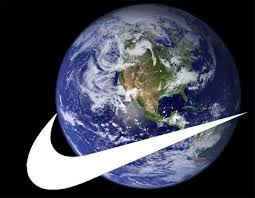Nike organisation:
The American Multinational Corporation Nike is specialized in the designing, developing, manufacturing, marketing and selling of footwear, apparel, equipment, accessories, recreational products and services all across the world. It is one of the world’s famous and largest suppliers of sports shoes and equipment. The company is headquartered in Washington County, Oregon in the United States of America. Before going through Nike organizational structure it is wise to mention that the term organizational structure refers to “the vertical and horizontal configuration of departments, authority and jobs within a company” (Williams and McWilliams, 2010, p.175). The organizational process involves “The collection of activities that transform inputs into out puts that customer’s value” (Williams and McWilliams, 2010, p.175).
Nike Corporation mission is known worldwide as the following phrase: “To bring inspiration and innovation to every athlete in the world” (McGlone and Martin 2006). Due to the wide scale of businesses Nike has developed a strong and effective organizational structure that ensures continuous innovation and improvement.
The corporation is headed by: –
– The Chairman of the Board of Directors (jointly oversee the activities of Nike).
– The President and Chief Executive Officer (in charge of total management of Nike).
Both are deputized by the following: –
* Executive Vice President, Global Human Resources (oversees all human resource management and industrial relations operations for Nike and other responsibilities including talent scouting, development, inspiration, retention and infrastructure planning for all worldwide employees in the Nike Brand and affiliate organizations).
* Executive Vice President & Chief Financial Officer (oversees all financial activities of Nike and investor relations).
* President, NIKE Brand (leading all category and geographic business units, Digital Sport and brand management throughout the world as well as leading NIKE’s wholesale, retail and e-commerce operations.).
* President, Product & Merchandising (responsible for driving the strategy for creating all footwear, apparel and equipment for the company and leading the merchandising of product to the global marketplace.).
* Executive Vice President, Chief Administrative Officer & General Counsel (in charge of corporate law, mergers and acquisitions, brand protection, and government affairs).
* Executive Vice President, Global Sports Marketing (oversees all of Nike’s global sports marketing efforts, including managing relationships with Nike’s top athlete, team, league and federation partners).
* Chief Operating officer (leading all manufacturing, sourcing, IT and procurement for Nike and also oversees the company’s efforts to drive innovation in the supply chain.).
Nike has corporate governance as well includes the following:
* Vice President & Corporate Secretary.
* Vice President Treasurer & Investor Relations.
* Vice President, Corporate Controller.
The kind of organisation Nike uses shows that it applies the functional departmentalisation system whereby every department has a leader who derives his authority from the Chairperson and board members; this helps the focus on specific areas of interest. Functional departmentalisation involves grouping work and workers into separate units, responsible for particular business functions or areas of expertise. Advantages include: – work is done by highly skilled specialists; lower costs are incurred due to reduced duplication. Disadvantages include: – slower decision making, inter department coordination may be difficult, among others.
Reference List:
-
McGlone C and Martin N 2006, Nike’s Corporate Interest Lives Strong: A Case of Cause-Related
-
Marketing and leveraging , Sport MarHeting Quarteriy, 2006, 15, 184-189, © 2006 West Virginia University.
-
Nike INC, executives, Retrieved January 2, 2014, from http://nikeinc.com/pages/executives
